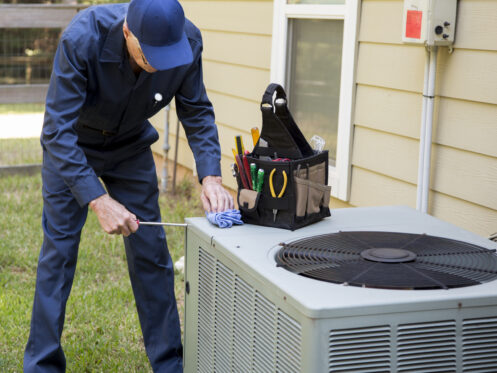Your home’s insulation impacts your HVAC system year-round. Provided it’s in good condition and has been properly installed, it can help with energy efficiency along with comfort. It’s always a good idea to address any potential insulation issues promptly. Before investing in insulation services, though, you should understand its role and how it comes into play during Roseville’s warmer months of the year.
Understanding Home Insulation
Home insulation refers to materials installed in homes to reduce heat transfer between the interior and exterior environments. Its primary purpose is to maintain a comfortable indoor temperature by minimizing heat gain in summer and heat loss in winter. Common insulation materials include fiberglass, cellulose, foam board and spray foam. These materials work by trapping pockets of air within their structure, creating a barrier that inhibits the transfer of heat. Some insulation materials have reflective surfaces that bounce radiant heat away from the home.
Fiberglass insulation is versatile and can work well in various types of homes, including new construction and existing structures. It’s commonly used in attics, walls, and crawl spaces due to its flexibility and effectiveness in providing thermal insulation.
Cellulose insulation, made from recycled paper and treated for fire resistance, is suitable for both new and older homes. It’s particularly effective for retrofitting existing structures because experts can blow into walls and attic spaces to fill gaps and voids.
Foam board insulation, known for its high insulating value, works best in homes with relatively straightforward insulation needs. Its superior thermal resistance and moisture management make it a popular choice for use in foundation walls, roofing and external walls.
Spray foam is another highly versatile and adaptable type of insulation. It’s a common choice for creating an air barrier and improving energy efficiency in inconvenient places like crawl spaces, attics and regions around structures with unusual angles and shapes.
Benefits of Proper Home Insulation in Summer
It’s important to note that insulation doesn’t generally keep outside air from getting into your home; that’s the job of weatherstripping, caulking and other sealing methods. Though insulation can help with air leakage, it’s job is actually to slow down heat transfer to keep your home’s temperature consistent. Doing so means your air conditioning system doesn’t need to work as hard or run as frequently to maintain a comfortable indoor temperature. Rooms will remain cooler and more comfortable, with fewer hot spots or fluctuations in temperature. As a result, homeowners can significantly reduce their energy consumption and save on cooling costs.
Common Areas for Insulation in Summer
During the summer, several key areas in a home require proper insulation to maintain optimal indoor comfort and energy efficiency. Attics tend to trap heat, which can seep into the living spaces below if not adequately insulated. Insulating the attic roof and walls helps keep that heat out of the space. Placing insulation between the attic and the rest of the home, though, can also help stop the trapped heat from making its way into your home and burdening the HVAC system. Proper ventilation also helps to expel hot air from the attic, further aiding in temperature regulation and preventing moisture buildup.
Wall insulation is another essential aspect of summer insulation. Exterior walls can absorb heat from the sun, raising indoor temperatures and making the home less comfortable. Like with the attic, proper insulation within those walls minimizes the amount of heat that gets into your home, reducing the workload on the cooling system.
Floor and crawl space insulation are commonly overlooked but can significantly impact indoor comfort during the summer. Insulating floors above unconditioned spaces, such as crawl spaces or garages, helps prevent heat from transferring into the home from below. Because heat rises, this can be surprisingly important in maintaining cooler indoor temperatures without having to rely excessively on air conditioning.
Poorly insulated windows and doors can allow heat to penetrate the home, raising indoor temperatures and increasing cooling costs. While part of this is the insulation that goes around the window frames, windows themselves play a role in insulation as well. Single-pane windows don’t place a barrier between your home’s interior and exterior other than the single piece of glass. Many newer windows, though, use air as insulation, utilizing multiple panes to slow the transfer of heat. Also, making sure your windows and doors are sealed so that air doesn’t escape or make its way in can help insulation do its job.
In addition to these common areas, homeowners should also consider insulating other potential sources of heat gain, such as basement walls, ductwork and air conditioning ducts. Insulating these spaces allows homeowners to make their homes more energy efficient and pleasant to live in, which in turn lowers cooling bills and makes summers more bearable.
Signs of Poor Home Insulation
Uneven cooling is a frequent sign of inadequate insulation. Inadequate insulation allows heat to transfer more easily between indoor and outdoor spaces, resulting in areas of the home that are significantly warmer than others. This can create discomfort for occupants and may require the cooling system to work harder to maintain a consistent temperature during the summer.
Higher energy bills are another indicator of poor insulation. When a home is not properly insulated, heating and cooling systems must work harder to compensate for heat gain or loss, leading to higher energy consumption and utility costs.
Tips for Improving Home Insulation in Summer
In addition to ensuring proper insulation in the home, conducting regular home energy audits can further enhance energy efficiency and comfort. These audits involve a comprehensive assessment of the home’s energy usage and efficiency. Homeowners can use them to cut down on energy use and save money on utility bills. Homeowners may also want to consider installing reflective or radiant barriers in their attics or crawl spaces. These barriers reflect radiant heat away from the home, reducing some of the heat that insulation needs to combat.
DIY vs. Professional Insulation Installation
While it may be tempting to tackle home insulation as a DIY project, there are several drawbacks to consider. One major issue is the complexity of properly assessing insulation needs and selecting the right materials for each area of the home. DIY attempts often result in inadequate insulation coverage or incorrect installation techniques, leading to inefficiencies and potential safety hazards.
Professionals have the expertise and experience to accurately assess insulation requirements and install materials correctly. They understand building codes and safety regulations, ensuring compliance and peace of mind for homeowners. Plus, professionals have access to specialized equipment and tools that are necessary for efficient and effective insulation installation. Experts in the field can do insulation jobs quickly, effectively and with little mess.
What to Expect
When hiring professionals to insulate your home, expect them to conduct a thorough assessment of your property to determine your insulation needs. They’ll discuss insulation options suitable for your home’s layout, climate and energy efficiency goals. After selecting the appropriate insulation materials, the contractors will schedule the installation, which typically involves sealing gaps, filling voids and ensuring proper coverage throughout the designated areas. Throughout the process, they’ll prioritize safety measures and adhere to industry standards. Once they’re done, they’ll conduct a final inspection to ensure quality and effectiveness.
When you need HVAC, plumbing, indoor air quality or insulation services in Roseville, call Environmental Heating & Air Solutions.

